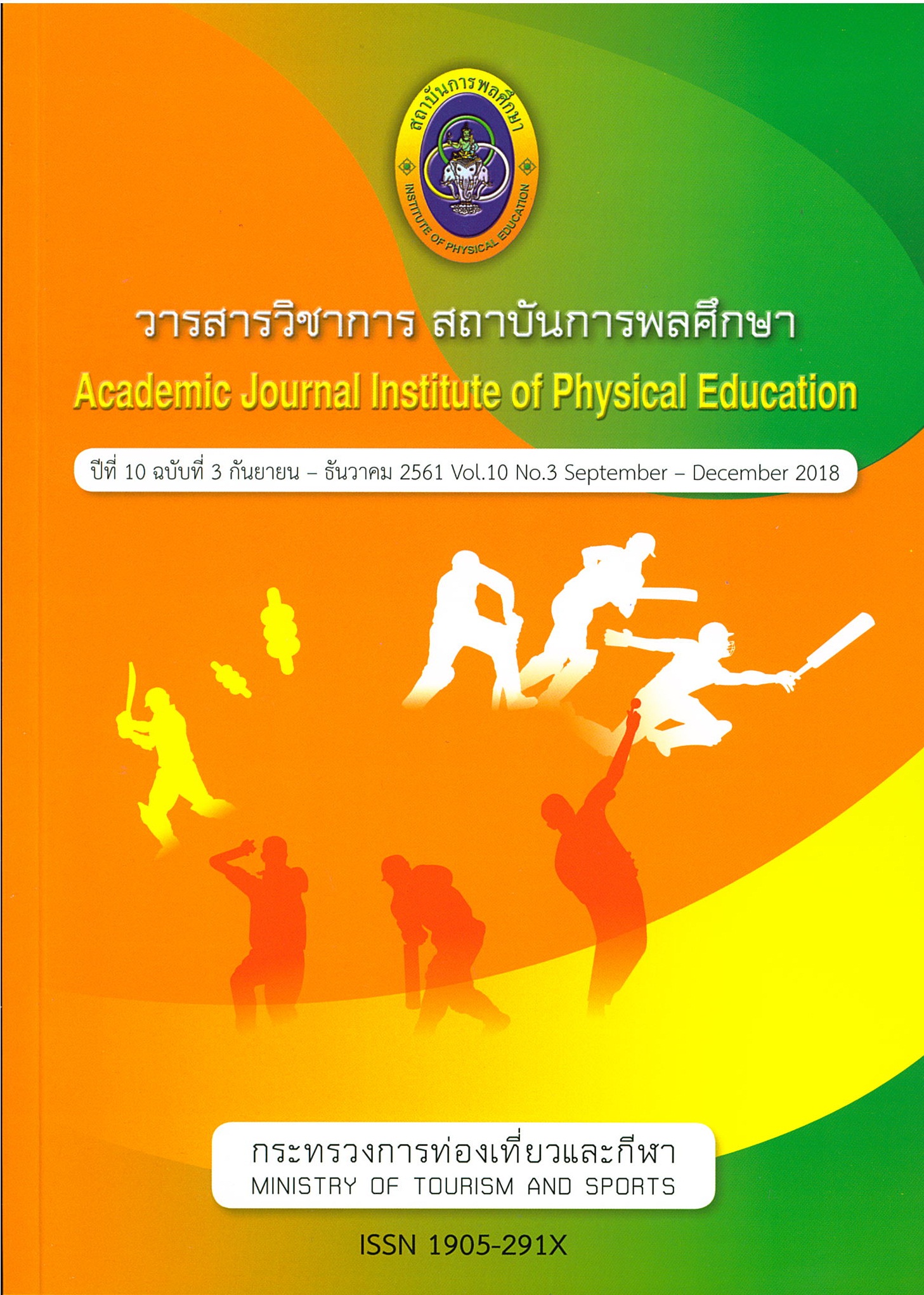The Management Model of National Takraw Training Center
Main Article Content
Abstract
The objective of this study is to propose the management model of the National Takraw training center by analyzing the current situation of the national Takraw training center and to
illustrate the key factors of its management.The data was collected from document review, focus group of the executive committee of Takraw Association of Thailand, in-depthinterview
from 13 experts, and the questionnaire from 80 practitioners by purposive sampling. The research instrument is a semi-structured interview and questionnaire.The research tools were
assessed by index of item objective congruence and Alpha Coefficient from 5 experts. The reliability is 0.94.The management model created from this study was measured by public
hearing from 9 experts to reassure the appropriateness and its benefit. The result demonstrates that recently the national Takraw training center was managed following the principleof service marketing, resources management, management process, and network management, but itcould not driveand develop effectively.The positionof its strategies is inSO (strengthand opportunity) which means thetraining centerhas a strength from itself and has got an opportunity from the external factors. Actually, the national Takraw training center could apply these findings to establish the direction of its development to fit the goal. The key factors of the national Takraw training center comprise service marketing, resources management, management process and network management. These essential factors would deliver the operation of the training center to be more efficiently and sustainability. Inconclusion, the management model appropriated for the development of the national Takraw training center includes of strategy establishment, working structure, operational, and evaluation. The administrative committee of the national Takraw training center can apply these findings to practice systematically and to develop Takraw sustainability.
Article Details
The published article is a copyright of the Academic Journal of Thailand National Sports University. The passage appeared in each article in this academic journal is a perspective of each author which is not related to the journal. Each author is required to be responsible for all components of his/her own article. If there are any mistakes, each author must be responsible for those mistakes on his/her own.
References
กระทรวงการท่องเที่ยวและกีฬา. (2560). แผนพัฒนาการกีฬาแห่งชาติ ฉบับที่ 6 พ.ศ. 2560-2564. กรุงเทพมหานคร: สำนักงานกิจการ โรงพิมพ์องค์กรสงเคราะห์ทหารผ่านศึก.
ธนพฤกษ์ชามะรัตน์. (2554). การสร้างเครือข่ายทางสังคมของนายหน้าแรงงานอีสาน. วิทยานิพนธ์ปรัชญาดุษฎีบัณฑิต สาขาวิชาสังคมวิทยา, มหาวิทยาลัยขอนแก่น.
นิตยาพร สายเสนา. (2550). การบริหารจัดการแบบพึ่งตนเองของสนามกีฬาสมโภชเชียงใหม่ 700 ปี. วิทยานิพนธ์ศิลปศาสตรมหาบัณฑิต สาขาวิชาการจัดการทางกีฬา, มหาวิทยาลัยมหิดล.
นิยม ดวงมณี. (2558). แนวทางการบริหารจัดการศูนย์ฝึกกีฬาแห่งชาติลาว. วิทยานิพนธ์วิทยาศาสตรมหาบัณฑิต สาขาวิชาวิทยาศาสตร์การออกกำลังกายและการกีฬา, มหาวิทยาลัยบูรพา.
ปณิศา มีจินดา และศิริวรรณ เสรีรัตน์. (2554). กลยุทธ์การตลาดและการวางแผน. กรุงเทพฯ: บริษัทธรรมสาร.
ปราณีบุญเกลี้ยง. (2555). การบริหารจัดการกีฬาอาชีพของสมาคมวอลเลย์บอลแห่งประเทศไทย. วิทยานิพนธ์วิทยาศาสตรมหาบัณฑิต สาขาวิทยาศาสตร์การกีฬา, มหาวิทยาลัยเชียงใหม่.
ปวีณาอุทุมภา. (2547). ปัจจัยที่มีผลต่อการใช้บริการศูนย์วิทยาศาสตร์การกีฬา วิทยาลัยพลศึกษา จังหวัดชัยภูมิ. วิทยานิพนธ์บริหารธุรกิจมหาบัณฑิต. สาขาบริหารธุรกิจ,
พิตรพิบูล ไชยเมือง, สังคม ศุภรัตนกุล ประจญ กิ่งมิ่งแฮ และณัฐ อมรภิญโญ. (2558). “รูปแบบการเสริมสร้างเครือข่ายทางสังคมที่มีอิทธิพลต่อคุณภาพการบริหารจัดการ”. วารสารมหาวิทยาลัยนครพนม 5(1): 44-52.
วีระพงษ์บางท่าไม้. (2557).รูปแบบสถาบันพัฒนาบุคลากรกีฬาแห่งประเทศไทย.วิทยานิพนธ์ปรัชญาดุษฎีบัณฑิต สาขาวิชาวิทยาศาสตร์การกีฬา, มหาวิทยาลัยบูรพา.
ศิริวรรณ เสรีรัตน์ และสมชาย หิรัญกิตติ. (2542). องค์การและการจัดการ. ฉบับปรับปรุงใหม่. กรุงเทพฯ: ธีระฟิลม์และไซเท็กซ์.
ศิริวรรณ เสรีรัตน์และคณะ. (2555). การบริหารการโฆษณาและการสื่อสารการตลาดแบบบูรณาการ. กรุงเทพฯ: ธรรมสาร.
สมาคมตะกร้อแห่งประเทศไทย. (2555).ยุทธศาสตร์ตะกร้อ พ.ศ. 2555-2559.กรุงเทพฯ:สมาคมตะกร้อแห่งประเทศไทย.
สุดใจ วันอุดมเดชาชัย. (2556). การจัดการเชิงกลยุทธ์. กรุงเทพฯ: สำนักพิมพ์สามลดา.
สุพิตร สมาหิโต. (2555). อุตสาหกรรมกีฬากับการสร้างมูลค่าเพิ่มของประเทศ. กรุงเทพฯ: มหาวิทยาลัยเกษตรศาสตร์.
เสรีพงศ์พิศ. (2548). เครือข่าย: ยุทธวิธีเพื่อประชาคมเข้มข้นชุมชนเข้มแข็ง.กรุงเทพฯ: โครงการมหาวิทยาลัยชีวิตสถาบันการเรียนรู้เพื่อปวงชน
อดุลย์จาตุรงคกุล. (2551). การบริหารการตลาดยุคใหม่. กรุงเทพฯ: โรงพิมพิมพ์มหาวิทยาลัยธรรมศาตร์.
Best, J.W. 1981. Research in Education. 4th ed. New Jersey: Prentice-Hall.
Belah. G.E. &Belch, M. A., (2012). Advertising and Promotion. 9th ed. Singapore: McGraw-Hill.
Daft, R. and L. Richard. (2006). Management. 8th ed., Thomson Leaning, Inc. Daft, Richard L.
Drucker, P. and F. Peter. (2005). The practice of management. New York: Harper & Row.
Kotler, P. (2006). Marketing Management. 12th ed. Upper Saddle River, New Jersey: Prentice-Hall.


